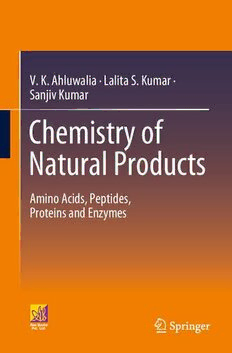
Chemistry of Natural Products. Amino Acids, Peptides, Proteins and Enzymes PDF
Preview Chemistry of Natural Products. Amino Acids, Peptides, Proteins and Enzymes
V. K. Ahluwalia · Lalita S. Kumar · Sanjiv Kumar Chemistry of Natural Products Amino Acids, Peptides, Proteins and Enzymes Chemistry of Natural Products · · V. K. Ahluwalia Lalita S. Kumar Sanjiv Kumar Chemistry of Natural Products Amino Acids, Peptides, Proteins and Enzymes V.K.Ahluwalia LalitaS.Kumar DepartmentofChemistry SchoolofSciences UniversityofDelhi IndiraGandhiNationalOpenUniversity NewDelhi,India NewDelhi,India SanjivKumar SchoolofSciences IndiraGandhiNationalOpenUniversity NewDelhi,India ISBN978-3-030-86697-6 ISBN978-3-030-86698-3 (eBook) https://doi.org/10.1007/978-3-030-86698-3 JointlypublishedwithANEBooksPvt.Ltd. Inadditiontothisprintededition,thereisalocalprintededitionofthisworkavailableviaAneBooksin SouthAsia(India,Pakistan,SriLanka,Bangladesh,NepalandBhutan)andAfrica(allcountriesinthe Africansubcontinent). ISBNoftheCo-Publisher’sedition:9781420059175. ©TheAuthor(s)2022 Thisworkissubjecttocopyright.AllrightsaresolelyandexclusivelylicensedbythePublisher,whether thewholeorpartofthematerialisconcerned,specificallytherightsofreprinting,reuseofillustrations, recitation,broadcasting,reproductiononmicrofilmsorinanyotherphysicalway,andtransmissionor informationstorageandretrieval,electronicadaptation,computersoftware,orbysimilarordissimilar methodologynowknownorhereafterdeveloped. Theuseofgeneraldescriptivenames,registerednames,trademarks,servicemarks,etc.inthispublication doesnotimply,evenintheabsenceofaspecificstatement,thatsuchnamesareexemptfromtherelevant protectivelawsandregulationsandthereforefreeforgeneraluse. Thepublishers,theauthors,andtheeditorsaresafetoassumethattheadviceandinformationinthisbook arebelievedtobetrueandaccurateatthedateofpublication.Neitherthepublishersnortheauthorsor theeditorsgiveawarranty,expressedorimplied,withrespecttothematerialcontainedhereinorforany errorsoromissionsthatmayhavebeenmade.Thepublishersremainneutralwithregardtojurisdictional claimsinpublishedmapsandinstitutionalaffiliations. ThisSpringerimprintispublishedbytheregisteredcompanySpringerNatureSwitzerlandAG Theregisteredcompanyaddressis:Gewerbestrasse11,6330Cham,Switzerland Preface The study of ‘Natural Products’ is an integral part of the undergraduate and the postgraduate curriculum across universities in India. A need for a comprehensive textcoveringdifferentareasofnaturalproductchemistryinreasonabledetailisfelt bythestudentsandteachersalike.Thisbookoffersreadersjusttherightinformation inamostconciseandarticulatemannerwithoutdilutingtheimportanceofthesubject matter. Thebookisdesignedfortheundergraduate(bothatpassandathonourslevels) andthepostgraduatestudentsofchemistry.Thetextwouldbeequallyusefultothe learnersininterdisciplinaryareaslikebiochemistry,biotechnology,etc.,andwould provideagoodfoundationtotheonesventuringintoresearchintheareascovered inthetext,especiallypeptidesynthesis. Thetextisdividedintofourchapters—achaptereachdedicatedtoaminoacids, peptides, proteins and enzymes. Chapter 1 on ‘Amino Acids’ covers nomencla- ture,classification,stereochemistry,physicalandchemicalproperties,synthesisand industrial applications. The important reactions have been explained with the help ofmechanismsinvolved. Chapter2on‘Peptides’explainstheformationandstructureofpeptidebondand itssignificance.Thechaptergivesadetailedaccountofthesolution-phaseandsolid- phase synthesis of peptides besides discussing the structure and function of some biologicallyimportantpeptides. Chapter 3 on ‘Proteins’ discusses different ways of classification and explains theirproperties.Thestructuralorganisationofproteinshasbeencoveredinadequate detailsincludingtheprimarystructuredetermination. Chapter 4 on ‘Enzymes’ is a logical extension of the coverage in the first three chapters.Itcoverstheclassification,nomenclatureandmodeofactionofenzymes besidesadetailedaccountofthestructureandfunctionofdifferentcoenzymes. TheauthorswishtoacknowledgeProf.J.M.KhuranaoftheUniversityofDelhi tohavegonethroughthemanuscript.Welookforwardtocriticalcommentsfromthe usersofthetextandwouldwelcomepointerstoerrors,omissionsandobscurities(if any)soastoimprovethebookforfutureuse. v vi Preface Lastly,theauthorsexpresstheirsincerethankstoMr.SunilSexenaandallstaff membersofAneBooks,India,fortheirhelpandtheexcellentcooperationreceived. NewDelhi,India V.K.Ahluwalia LalitaS.Kumar SanjivKumar Contents 1 AminoAcids ................................................... 1 1.1 Introduction ............................................... 1 1.2 NomenclatureofAminoAcids ............................... 2 1.2.1 RepresentationofAminoAcids ........................ 5 1.3 ClassificationofAminoAcids ................................ 7 1.3.1 CodedorPrimaryProteinAminoAcids ................. 7 1.3.2 SecondaryandTertiaryProteinAminoAcids ............ 11 1.3.3 Non-codedorNon-proteinAminoAcids ................ 12 1.3.4 EssentialAminoAcids ................................ 13 1.4 StereochemicalAspectsofα-AminoAcids ..................... 14 1.4.1 AbsoluteConfigurationofα-AminoAcids ............... 15 1.4.2 AminoAcidswithTwoChiralCentres .................. 18 1.5 PhysicalPropertiesofα-AminoAcids ......................... 20 1.5.1 GeneralPhysicalProperties ........................... 20 1.5.2 Acid-BasePropertiesofAminoAcids ................... 20 1.5.3 SpectralPropertiesofα-AminoAcids ................... 26 1.6 ChemicalReactionsofAminoAcids .......................... 32 1.6.1 ReactionsDuetoAminoGroup ........................ 32 1.6.2 ReactionsDuetoCarboxylGroup ...................... 35 1.6.3 ReactionsDuetoBothAminoandCarboxylGroups ...... 36 1.7 IndustrialPreparationofα-AminoAcids ....................... 39 1.8 ChemicalSynthesisofα-AminoAcids ........................ 40 1.8.1 EnantiomericResolutionofα-AminoAcids .............. 51 1.8.2 AsymmetricSynthesisofα-AminoAcids ................ 53 1.9 IndustrialApplicationsofα-AminoAcids ...................... 62 2 Peptides ....................................................... 67 2.1 Introduction ............................................... 67 2.2 StructureandClassificationofPeptides ........................ 68 2.2.1 StructureofPeptideBond ............................. 68 2.2.2 ClassificationofPeptides .............................. 71 vii viii Contents 2.3 NomenclatureofPeptides ................................... 71 2.3.1 RepresentationofPeptidesandPolypeptides ............. 73 2.4 PeptideSynthesis ........................................... 74 2.4.1 ProtectionofAminoGroup ............................ 77 2.4.2 ProtectionofCarboxylGroup .......................... 86 2.4.3 ProtectionofSideChains ............................. 87 2.4.4 CouplingMethods ................................... 88 2.5 Solid-PhasePeptideSynthesis ................................ 95 2.5.1 Solid-PhasePeptideSynthesisUsingt-BocProtection (MerrifieldApproach) ................................ 98 2.5.2 Solid-PhasePeptideSynthesisUsingFmocProtection (Sheppard’sApproach) ............................... 100 2.5.3 LimitationsofSolid-PhasePeptideSynthesis ............ 100 2.6 SomeBiologicallyImportantPeptides ......................... 102 2.6.1 Oxytocin ........................................... 103 2.6.2 Glutathione ......................................... 104 2.6.3 Insulin .............................................. 107 2.6.4 Bradykinin .......................................... 108 2.6.5 GramicidinS ........................................ 109 3 Proteins ....................................................... 113 3.1 Introduction ............................................... 113 3.2 ClassificationofProteins .................................... 114 3.2.1 ClassificationontheBasisofShapeandStructure ........ 114 3.2.2 ClassificationontheBasisofProductsofHydrolysis ...... 116 3.2.3 ClassificationontheBasisofBiologicalFunctions ........ 120 3.3 PropertiesofProteins ....................................... 121 3.3.1 MolecularWeight .................................... 121 3.3.2 AmphotericNature ................................... 122 3.3.3 Solubility ........................................... 123 3.3.4 Precipitation ........................................ 123 3.3.5 Denaturation ........................................ 125 3.3.6 ColourReactions .................................... 125 3.4 StructuralOrganisationofProteins ............................ 128 3.4.1 CovalentorPrimaryStructureofProteins ............... 130 3.4.2 ConformationalAspectsofProteins:HigherOrder Structures ........................................... 144 4 Enzymes ...................................................... 157 4.1 Introduction ............................................... 157 4.2 NomenclatureandClassificationofEnzymes ................... 158 4.2.1 SystematicandRecommendedNames .................. 159 4.2.2 ClassificationNumbersandCodeNames ................ 159 4.3 CharacteristicsofEnzymes .................................. 166 4.3.1 CatalyticPower ...................................... 166 Contents ix 4.3.2 EnzymeSpecificity ................................... 168 4.3.3 EnzymeRegulation .................................. 170 4.4 MechanismofEnzymeAction ............................... 170 4.5 FactorsAffectingEnzymeAction ............................. 173 4.6 Chymotrypsin:AnEnzymeinAction .......................... 175 4.6.1 StructureofChymotrypsin ............................ 177 4.6.2 ImportantAminoAcidResiduesofChymotrypsin ........ 178 4.6.3 MechanismofAction ................................. 181 4.7 Cofactors(orCoenzymes) ................................... 185 4.7.1 Nicotinamide Adenine Dinucleotide (NAD+) andNicotinamideAdenineDinucleotidePhosphate (NADP+) ........................................... 187 4.7.2 UDP-Glucose ....................................... 190 4.7.3 FlavinMononucleotide(FMN)andFlavinAdenine Dinucleotide(FAD) .................................. 192 4.7.4 ThiaminePyrophosphate(TPP) ........................ 195 4.7.5 Cocarboxylase ....................................... 197 4.7.6 Pyridoxal-5-Phosphate ................................ 200 4.8 EnzymesinOrganicSynthesis ................................ 205 4.8.1 EnzymaticOxidations ................................ 207 4.8.2 EnzymaticHydroxylation ............................. 209 4.8.3 EnzymaticHydrolysis ................................ 210 4.8.4 EnzymaticReductions ................................ 211 4.8.5 EnzymaticIsomerisations ............................. 212 4.8.6 PharmaceuticalApplicationsofEnzymes ................ 212 SuggestedReadings ............................................. 214 Glossary .......................................................... 215 Index ............................................................. 233 About the Authors V.K.Ahluwalia hasworkedasprofessorofchemistry,UniversityofDelhi,Delhi for more than three decades and taught postgraduate and M.Phil students. He has guidedabout80studentsforM.Phil/Ph.Ddegreesandhaspublishedmorethan250 researchpapersinNationalandInternationalJournals.Hehasdeliveredanumberof invitedlecturesinIndiaandAbroad.Prof.Ahluwaliaworkedaspost-doctoralfellow for two years (1960-1962) and worked with Prof. Harold Shechter at the Depart- ment of Chemistry Ohio State University, Ohio USA and for one year (1980-81) withProfessorHerbertC.Brown,NobelLaureateattheDepartmentofChemistry, PurdueUniversity,USA.HehasalsobeenavisitingprofessoratDr.B.R.Ambedkar Centre for Biomedical Research University of Delhi, Delhi. Prof. Ahluwalia has authored many books a few of which are, Reaction Mechanism, Environmental Chemistry, Environmental Science, Environment Education, Environmental Pollu- tionandHealthandOrganicSynthesis.HisBookonGreenChemistryisthewinner 2009Choiceaward,beingtheoutstandingacademictitle. LalitaS.KumardidherPhDfromUniversityofDelhiintheyear1987intheareaof SyntheticOrganicChemistry.Shehasfivepublicationstohercredit.Sheisworking as Reader at Indira Gandhi National Open University (IGNOU), New Delhi. She hasbeenassociatedwithdesign,developmentandmaintenanceofdistanceteaching materialforoversixteenyears.Herareasofinterestarebiochemistry,organicreaction mechanismandenvironmentalchemistry. SanjivKumardidhisPhDfromUniversityofDelhiintheyear1990intheareaof biophysicalchemistryforwhichheworkedoninteractionofpeptidesandproteins withnuclearacids.HeisworkingasReaderatDeshbandhuCollege,Universityof Delhi,andhasateachingexperienceofoversixteenyears.Hisareasofinterestare biochemistry,spectroscopyandquantumchemistry. xi
